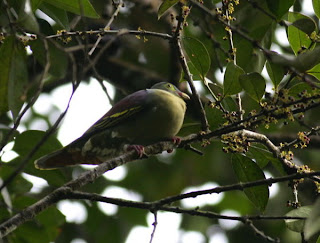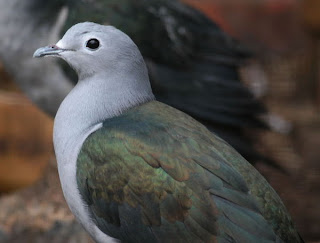The Milky Stork (Mycteria cinerea) is found
in coastal wetlands ranging from Cambodia, Peninsular Malaysia and the islands
of Sumatra, Java, Bali, Sumbawa, Sulawesi and Buton in Indonesia. Due to
habitat loss, today there are around 5,500 left in the wild mainly in Sumatra.
The Milky Stork feeds on small animals including shellfish, insects, fish, and
frogs.
It can reach a length of 97 cm. The sexes look similar. The plumage is general white contrasted with a naked red face and a long shiny green-black tail and flight-feathers. The other cousin is the Painted Stork which differentiate from the former by having more black plum to its b body and its stork is much shorter.
In Peninsula it is a rarity to see them in the wild. The species is a predominantly a coastal resident, inhabiting mangroves and adjacent swamps. In 1989, 40-50 birds were shipped to zoos across south-east Asia. Poisoning may be another significant, as yet unquantified, threat.
Conservation is essential This has prompted MNS, together with Zoo Negara and the Wildlife and National Parks Department (Perhilitan), to start breeding programme at the Kuala Selangor Nature Park. It was warned that the milky stork will go extinct soon if their habitat is not conserved............sad
Please go to to read more on this bird conservation finding :-http://malaysia.wetlands.org/WHATWEDO/WetlandBiodiversityandWaterbirds/MilkyStorks/tabid/1079/Default.aspx
It can reach a length of 97 cm. The sexes look similar. The plumage is general white contrasted with a naked red face and a long shiny green-black tail and flight-feathers. The other cousin is the Painted Stork which differentiate from the former by having more black plum to its b body and its stork is much shorter.
In Peninsula it is a rarity to see them in the wild. The species is a predominantly a coastal resident, inhabiting mangroves and adjacent swamps. In 1989, 40-50 birds were shipped to zoos across south-east Asia. Poisoning may be another significant, as yet unquantified, threat.
Conservation is essential This has prompted MNS, together with Zoo Negara and the Wildlife and National Parks Department (Perhilitan), to start breeding programme at the Kuala Selangor Nature Park. It was warned that the milky stork will go extinct soon if their habitat is not conserved............sad
Please go to to read more on this bird conservation finding :-http://malaysia.wetlands.org/WHATWEDO/WetlandBiodiversityandWaterbirds/MilkyStorks/tabid/1079/Default.aspx


















































